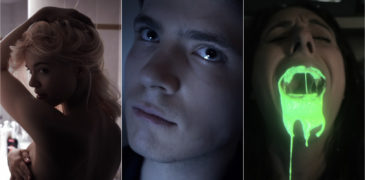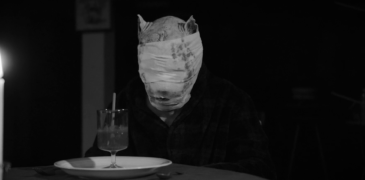
Aspiring DJ, Andy, has his fate intertwined with a woman named Lela after he saves her after one of his sets. Lela, who is also secretly the DJ’s biggest fan, is dealing with her own issues due to a troubled past in which her mother’s death sent her spiraling into a world of prophetic nightmares. As she heads to Japan to solve the mystery of her upbringing, Andy begins to experience similar visions, from other ends of the world the two begin to fight an ancient evil using the power of music and magic. Bashira gets its name from a creature bound to young Lela and set to bring about the end of the world.

Defying logic, Bashira is an odd mish-mash of various influences spanning different genres and aesthetics. In fact, without looking up director Fong Nickson one may guess his age to be anywhere between 20 and 50. This discrepancy comes from the fact that the film tries to appeal to Gen-Z while simultaneously showing instances that lack a basic understanding of the generation. Truth is, Nickson’s age is irrelevant to the actual end product, but rather a means to frame the film’s shortcomings as well as the ingenuity that makes it a truly unique beast.
An overly ambitious plot is pushed by underfunded CGI, random musical numbers, and long droning plots. There are also different cultural inspirations, such as American romance, Chinese action, and Japanese horror film–Bashira is not short on ideas.
The CGI reflects earlier eras with a quality that seems straight from the PS3, though its limitations are covered up by an oversaturated of bright colors. Additionally, effects are used liberally with unnecessary items rendered into almost every scene. Is it rough looking? Certainly. However, the time spent and attention to detail is actually one of the production’s greatest charms. The creature designs, in particular, are menacing and convey the grandiose power the production builds towards. This is particularly true with the reveal of the titular Bashira, whose daunting figure gives reason for the questionable CGI that preceded the reveal.
The times where the graphics don’t seem as suiting is when they are used for minor instances and in transitions. Often, scene changes have the actors disappearing in a cloud of smoke without really adding to context. Furthermore, the transition of the musical number into a fully 3D environment looks both cheap and dated (again the clash of old meets new). This results in an odd disconnect, where many scenes have a haphazard layer of effects that give the visuals an uncanny aesthetic. Consequently, Bashira can come across as watching pieced-together cut scenes from a videogame.
The videogame comparison is apt in more ways than one. The plot itself is rather disjointed and confusing, with much of the dialogue coming across as NPC interactions. Think of cutscenes from the likes of a Silent Hill or a Fatal Frame–not to say those stories are lacking, but there is an undeniable difference in flow between dialogue in videogames and film. The middle portion of the two-hour feature does attempt to fix this issue with an exposition dump, yet it is difficult to shake the sensation of watching a montage of cutscenes where some of the contexts are lost in the gameplay that would have framed it with more clarity.

There is one element of the production that is bound to be met with universal critique; the middle section that is heavy on exposition is a complete slog within the two-hour time frame. Mudding the matters is a rather convoluted plotline (again reflective of videogame narratives) that tries to evoke emotions and a sense of awe from its viewer, but acts to highlight the shortcomings of the largely unoriginal and confusing script. The best part of Bashira, undeniably, rests with the ingenuity and ambition of the project over the storyline.
While the words above paint a rather negative portrait of Bashira, there is no denying it has its charms and the potential to appeal to an audience. Every negative, with the right viewer, can be seen as a positive, especially if leaning on nostalgia for all the influences that make up the odd framework. At the same time, it is obvious that Nickson is straddling youthful aspirations with an older aesthetic in how heavy the work tries to appeal to younger kids while somewhat coming off as an older generation interpretation of what ’20-somethings’ are like. This is another attribute that will only further divide opinion based on the viewer’s age group, which while either be annoyed by the shallowness or see it as a modest (though slightly misguided) take on “what kids are like these days”.
To pull it to a personal note, which is the only way to tackle a film like this, my time with Bashira was a pleasure and it was refreshing to get something utterly unique (even with some of those elements coming from failure). The exposition dump of the middle section was the only part I disliked, but the simple graphics, cheesy musical numbers, and emphasis on folklore and music as a means to battle evil all appealed to my tastes. That said, another person’s critique that sees nothing of value in the work would be welcome as a legitimate take as well–you can’t deny Bashira is all over the place and wrought with bad choices.
My final score is reflective of my personal experience, so take it with a grain of salt as it is understandable from an alternative standpoint that the film has little redeeming qualities. Ultimately, it is best to give Bashira a shot for yourself, at the very least you will experience an original work that has the heart and soul of Fong Nickson poured into it.
We Watched Bashira as Part of the 2022 Fantaspoa Film Festival Line-up


More Film Reviews
Freaks Out (2021) Movie Review – Run Away And Join The Circus
Sometimes a movie packs so much content and creativity that it’s easy to forgive any flaws along the way. Freaks Out, the latest effort from They Call Me Jeeg Robot director Gabriele…
Sweetie, You Won’t Believe It Movie Review – Fantasia Festival 2021
Fishing doesn’t have the best reputation in fiction. Going off literature and film and Dick Cheney, one gets the impression it’s boring, it’s vaguely cruel, and it mostly serves as…
Ad Lib Short (2022) Short Film Review
Why people remain in situations of domestic abuse can be difficult for outsiders to understand. That is because there are unseen, powerful forces that keep victims in dangerous, toxic relationships….
Homoerotic Subtext in Daniel Isn’t Real (2019) Film Review – Homoeroticism is Hard as Ever
There’s an alluring quality that surrounds the link between horror and the queer community, from its roots in the 18th and 19th century with the emergence of queer coded Gothic fiction…
Greywood’s Plot (2020) Film Review – A Low Budget Exercise of Creativity
“You become what you believe” seems to be an enthusiastic phrase until you watch Josh Stifter’s black comedy horror Greywood’s Plot. Born out of a low-budget production and undying devotion…
Devil Story (1986) Film Review – What a Lovable Lump of a Man
Resurfaced from the depths of the 80’s, Devil Story is an idyllic pick for 2021 Fantastic Fest, courtesy of the good folks at Vinegar Syndrome. A showcase of inept filmmaking,…





